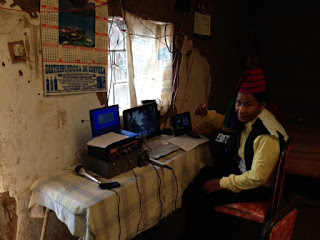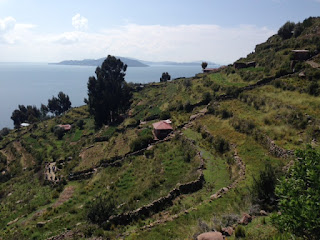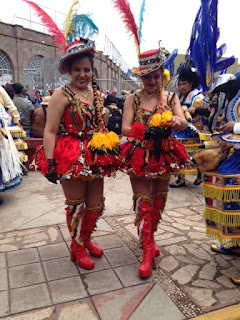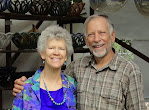Carnaval is Color and Movement and Sound.
After a day of rest and recuperation from their flight, plus enjoyment of the Puno Candalaria Festival, the Burritt/Carre family joined us on Taquile Island, where Carnaval is already in progress. We came on the boat on Tuesday, just enough time to prepare for the biggest party day, Wednesday, Feb. 14. In contrast to other Mardi Gras celebrations in the world, Ash Wednesday is the BIGGEST party day of the week. We had a delightful guest, Catarina from Italy, who joined us in dressing up and dancing.
Here Ruperta is helping Asa dress in the complicated clothing.
Women wear multiple skirts, red
mantas (large carrying shawls), intricately woven cummerbunds (called a
chumpi) with their black head covering (called a
chucko)
and carrying weechee-weechees, yarn pufts to twirl in their hands. The men also have red
mantas, often with a larger central pattern than the women's, also have the cummerbund
chumpis, but wear a full-sleeved colonial-style shirt, black short vest, often have red banderas across their chests, and carry longer weechee-weechees than the women. They also wear multiple coca-purses (
chuspas), sometimes as many of 15, carefully set to the same length so the fringe resembles a skirt.
 |
| Notice the grasshopper; I've never seen a grasshopper on Taquile. |
I wore 5 skirts on Wednesday and found that their weight with dance's hip movements introduced new muscles in my body. I switched to 4 skirts for the rest of the week.
Each of the 9 dance groups gather in the Plaza after lunch, dressed in their finest, and compete one-group-by-one in front of the autoridades. They also play music and dance in cacaphony, various groups playing at the same time in glorious confusion.
The festival is a progressive party, dancing in procession from one house to another. The leaders of the various groups are officers in the community, invited to various houses by relatives or friends. This culture is very strong on recipocity, so invitations flourish depending on relationship. We danced with two different groups, that of Dario from nearly the far west end of the island, and with Nestor's group. We had plenty of family and friends in both groups and hosted each in our home, one on Thursday and the other on Friday. We bought lake trout to serve our guests.
How it all works: The procession is lead by the youngest and most energetic women,
sipas munay, in the brightest skirts. Dario's group had a very large group of these beautiful young women and I joined them most of the time, whooping with the drums and flutes of the men, who follow behind the leader. Trailing the main group are grandmothers and young mothers carrying their babies. The last of the procession is the matriarch, the wife of the group's leader, who gathers up the stragglers and drunks to get to the next location.
When we get to the house, the men leaders sit on a bench and the women sit on sheepskins on the ground opposite them.
Food is served on a beautiful handwoven cloth, an uncuña, usually steamed new potatoes and reconstituted freeze-dried potatoes called chuño, and sometimes corn or fava beans. If fish are included, it is always a treat--and it goes fast. Always a spicy sauce is included, either an onion/tomato/roccotto pepper/lemon mix, or as in the following picture, cooked onions with yellow peppers called aji. Everyone comes forward to pick up handsfull of food.
After the main dish, watermelon is served. One for the women, one for the men, and another for the band. OOPS, NO WATERMELON PICTURE--TO BE ADDED, STAY TUNED.
We dance for awhile in the house; here two little boys manage the drums.
Beautiful child enjoys the party, too, especially the watermelon.
 |
| Waving the weechee-weechee as we exit the house |
With the watermelon comes the beer, shared all around, and then coca is offered and off we dance to the next house.
Cantuta, Taquile's official flower, blesses the foreground of the procession.
Here the procession climbs down the steep stairs toward the Chilcano port--only 2/3 of the famous 500 steps--to Zenon's house.
When we dancers, ahead of the musicians, arrive at a grassy field, we enjoy jumping out onto the soft grass and dancing in a circle until the musicians and the rest of the procession catches up.
Dancing through one of Taquile's stone arches.
Note how the multiiple fringed chuspas resemble a skirt. This man jumped up on the side of the arch, waving his weechee-weechee, cheering the dancers and musicians on to the next house.
Alicia is so beautiful with her bright smile, colorful clothing and happy dancing.
Carnaval started on Monday with six autoridades leading the six groups. Then on Wednesday, the three top officers, the Mayor and two more, started their groups. All danced for the rest of the week, the top officers ending on Saturday evening.
Sunday evening around 4:30 the remaining groups again head for the plaza. Only this time the young women remove their outer skirts so only the bright (almost day-glo) yellows and greens are all the way round. The men also shed most of their layers. The resulting pairs swing hands in an almost running dance through and around the plaza. Again cacaphony reigns as multiple groups play and dance at once. Fireworks light the air; beer is shared all around. Energy is HIGH!
At last the groups dance off to the house of the authoridad leader, where soup is served and then more beer and then more coca. Sam and I escorted Dario to his house (he was a little drunk); Sam holding Dario's arm and me managing the flashlight. Turns out he lives a mile or two west of the plaza. Once we got there, we were served first, a soup with a nice piece of fish, and welcomed to sit with Dario's godparents who were now in charge. The young people put on the boom box with Cumbia and Reggeton and other all kinds of music. The patio filled with fun dancers. Sam and I showed off our swing dance. Brad and I as well. Asa stayed inside with the beer drinkers and got a new Quechua nickname. The evening was clear skies with bright southern hemisphere stars. We stayed until the planets rose and spent all of Monday resting. Well deserved rest.




























































